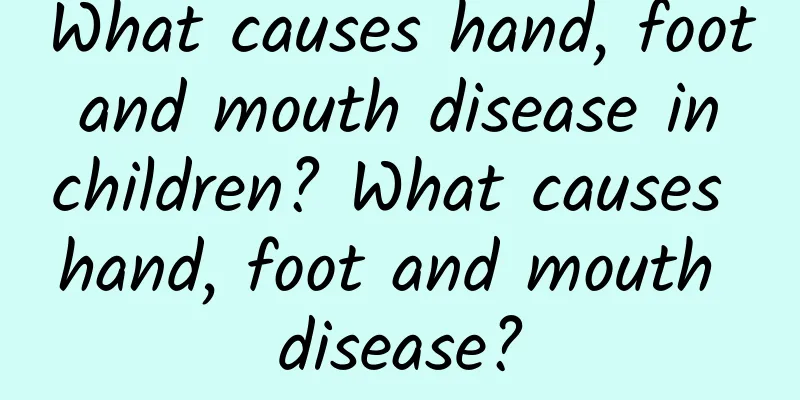What causes hand, foot and mouth disease in children? What causes hand, foot and mouth disease?

|
When it comes to hand, foot and mouth disease, many people will think of children with fever and blisters. Indeed, hand, foot and mouth disease is a common disease in infants and young children. It is contagious. Generally, sick infants need to be isolated to prevent them from infecting other children. What is the cause of hand, foot and mouth disease? Why do children get hand, foot and mouth disease? Let's learn about it together! 1. Enterovirus infection Hand, foot and mouth disease is caused by enterovirus infection, the most common of which are Coxsackievirus A16 and enterovirus 71. Its infection routes include the digestive tract, respiratory tract and contact transmission. Poor environmental hygiene, poor food hygiene and bad personal hygiene habits make it more susceptible to infection and disease. 2. Infection route 1. The patient's throat secretions, saliva, herpes fluid, and feces contain a large number of viruses. The viruses contaminate the hands or, through the hands, contaminate towels, handkerchiefs, cups, toys, eating utensils, milk utensils, bedding, clothes, etc. When other children take these things, they can eat the viruses into their mouths through their hands and become sick. 2. When the sick child coughs or talks, the virus in the throat secretions and saliva can be transmitted through the air (droplets), so close contact with sick children can cause infection. 3. It is easiest to be infected if you are in the same room with a sick child. 4. Infection may also occur by drinking or eating water or food contaminated by the virus. 3. Populations with a high risk of hand, foot and mouth disease 1. Infants and young children like to put their hands or toys in their mouths and bite them. The virus is transmitted through the digestive tract, so the incidence rate is higher in children under 5 years old. 2. It is common in nurseries and kindergartens, where infection is transmitted through handkerchiefs, towels, toys and other items contaminated with the virus. 3. Children do not know how to distinguish and eat food that has viruses or flies. Drinking or eating contaminated water and food can easily cause infection. 4. Notes So far, there is no vaccine or specific medicine for hand, foot and mouth disease, so parents should strengthen the three major hygienes: environmental hygiene, food hygiene, and personal hygiene. To prevent children from getting hand, foot and mouth disease, remember five tips: wash hands frequently, drink boiled water, eat cooked food, ventilate more, and dry clothes and quilts. 5. Rash care 1. Baby's clothes and bedding should be clean, comfortable, soft, and changed frequently. 2. Cut your baby's nails short and wrap your baby's hands if necessary to prevent scratching the rash. 3. For babies with rashes on their buttocks, their urine and feces should be cleaned at all times to keep their buttocks clean and dry. 4. In the early stage of skin rash on the hands and feet, you can apply calamine lotion. When herpes is formed or ruptured, apply 0.5% iodine tincture. 5. Pay attention to keep your skin clean to prevent secondary infection. |
<<: What fruits are good for children with diarrhea? What fruits can children with diarrhea eat?
Recommend
Symptoms of Tourette Syndrome
Tics, also known as Tourette syndrome, is a neuro...
What are the dangers of tonsillitis in children? Can removing the tonsils solve the problem once and for all?
Tonsils are an immune organ of the human body and...
How much can jaundice be reduced by 8 hours of blue light exposure
It is impossible to determine how much jaundice c...
What to do if your four-month-old baby coughs
When a four-month-old baby catches a cold, the sy...
Why does my child cough, cry, and feel listless?
Why does my child cough, cry, and feel listless? ...
What to do if your 4-month-old baby coughs
Coughing is a common respiratory disease in babie...
How mumps is transmitted in children
Mumps in children is mainly transmitted through d...
What kind of ointment is better for baby eczema? How to care for baby eczema?
Once a baby has eczema on his face, parents alway...
How to detect ADHD in children
In medicine, children with ADHD are generally cal...
How to prevent and treat congenital heart disease in children
Many young couples feel very scared when they hea...
Introduction to common diagnostic methods for Kawasaki disease
Many friends are familiar with Kawasaki disease. ...
How to distinguish between pneumonia and cold in children? How to use medicine rationally to recover quickly in children with pneumonia
The early symptoms of pediatric pneumonia are ver...
What should be paid attention to in the diet of pseudo-jaundice? What should be paid attention to in the diet of pseudo-jaundice?
Jaundice is a common disease that can occur in ch...
What causes diarrhea in children? Why do babies get diarrhea easily?
Many people are prone to diarrhea. Adults may rec...
What should I do if my child keeps coughing? How should I treat my child's constant cough?
Since children's throat and lung functions ar...









